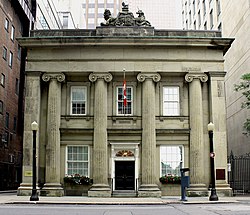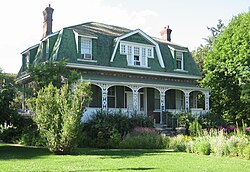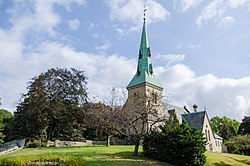Top Qs
Timeline
Chat
Perspective
List of oldest buildings and structures in Toronto
From Wikipedia, the free encyclopedia
Remove ads
This is a list of the oldest buildings and structures in Toronto, that were constructed before 1870. This corresponds to the first 75 years since the founding of York. The history of Toronto dates back to Indigenous settlements in the region approximately 12,000 years ago. However, the oldest standing structures in Toronto were built by European settlers. Remains of a Seneca settlement exist at the federally protected Bead Hill archaeological site, in eastern Toronto.
The first structure built by Europeans in Toronto was Magasin Royal, a French trading post established in 1720. In the 1750s, the French built several structures in the area (including Fort Rouillé), although the French would later destroy them in 1759, following their defeat at the Battle of Fort Niagara. In 1793, the government of Upper Canada arranged for the purchase of Toronto from the Mississaugas in order to settle newly landed British American colonists Loyalists, who were exiled from the United States of America after the Revolutionary War. Many of Toronto's oldest structures date back to this early period of British settlement, when it was known as York. The town of York was formally incorporated as the City of Toronto in 1834, with the passage of the Incorporation of the City of Toronto Act.
Remove ads
Surviving structures
Summarize
Perspective
The oldest intact structure of European settlement may be a piece of St Paul's Cathedral's courtyard railing dating from 1714, designed by Christopher Wren, that is now part of John Howard's tomb in High Park. Howard had it shipped from London in 1875.[1]
The following list does not include structures where only the facade of the building has been preserved. It also does not include the collection of buildings and structures collected at The Village at Black Creek. Those are listed at List of Village at Black Creek buildings.
1794 to 1819
Fort York was rebuilt after the original garrison was destroyed in the 1813 Battle of York. The site is a national historical site and its buildings, fortifications and cemetery are protected.
1820 to 1839
1840 to 1849
1850 to 1859
1860 to 1869
Reference keys
- ACO: Architectural Conservancy of Ontario (Toronto) - TOBuilt - SEARCHABLE TOBuilt DATABASE
- B: Benn1993[135]
- C: Cruikshank2003[136]
- CE: Canadian Encyclopedia
- CNHCD: Cabbagetown North Heritage Conservation District - Cabbagetown North Heritage Conservation District
- CoT: City of Toronto - Heritage bylaw citations
- CRHP: Canadian Register of Historic Places - HistoricPlaces.ca
- CSHCD: Cabbagetown South Heritage Conservation District - Cabbagetown South Heritage Conservation District
- EHS: Etobicoke Historical Society
- EYCPP: Etobicoke York Community Preservation Panel - Etobicoke York Pre-Confederation Architectural Treasures
- GO: Government of Ontario
- M: McHugh Bozikovic 2017[137]
- NRHCD: North Rosedale Heritage Conservation District - North Rosedale Heritage Conservation District Study
- OHT: Ontario Heritage Trust Ontario Heritage Trust
- PC: Parks Canada - National Historic Sites
- SLHCD: St Lawrence Heritage Conservation District - Archaeology -St. Lawrence Neighbourhood Heritage Conservation District Plan
- SRHCD: South Rosedale Heritage Conservation District - South Rosedale Heritage Conservation District Study
- THR: City of Toronto Heritage Register - "City of Toronto's Heritage Property Search". secure.toronto.ca. City of Toronto.
- TN: Toronto Neighbourhoods - Toronto Neighbourhoods
- TPL: Toronto Public Library - Digital Archive
- WHCD: Weston Heritage Conservation District - Weston Heritage Conservation District Plan - Phase I
- OTH: Other - see citation
Remove ads
See also
Notes
- Districts in this instance refers to the lower-tier municipalities of Metro Toronto, an upper-tier municipality that was dissolved in 1998. The City of Toronto was formed after the six lower-tier municipalities of Metro Toronto amalgamated into a single entity in 1998. The City of Toronto government does not formally organize areas of the city by "districts."
- The physical address of the building is shared with other buildings
- The building was enlarged in 1826
- The Brick Barracks consists of two three-roomed structures
- wings added after 1835 for Hedman
- Altered in 1865
- First floor only
- Building was renovated in 1856
- 1848 repairs/reconstruction due to fire
- Rebuilt in 1886
- Altered in 1895
- Altered in 1910
- Dedicated in 1847
- Altered in 1881
- Actual date of construction is unknown. Local lore suggests the building was erected c. 1795 by Augustus Jones, though studies on the site in 1996 suggests the building was erected in c. 1845 by James Humphreys.
- Incorporated into a complex addressed as 260 King Street East.
- Remodeled in 1885
- Remodelled in 1896
- The building's third floor was added to the building in 1905.
- additions in 1875
- 1895 addition by C.J. Gibson; altered 1910 by Hand, Harris & Merritt; altered 1914 by Hand, Harris & Merritt
- Mansard roof added in 1871
- Modified in 1917 and 1973
- mansard roof added in 1876; street level store added in 1912
- A fire destroyed 195 Church Street in 1981, although the building was rebuilt based on the building's original design.
- Building was incorporated into a condominium in 2015
References
External links
Wikiwand - on
Seamless Wikipedia browsing. On steroids.
Remove ads







































































































































































